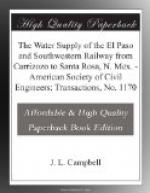TRANSACTIONS
Paper No. 1170
The water supply of the El Paso and Southwestern railway from Carrizozo to Santa Rosa, N. Mex.[A]
By J.L. Campbell, M. Am. Soc. C.E.
With discussion by Messrs G.E.P.
Smith, Kenneth Allan, and J.L.
Campbell.
Location.—The El Paso and Southwestern Railway traverses the arid country west of the 100th Meridian in New Mexico, Texas, and Arizona, as shown on the map, Fig. 1. The water supply herein described serves that division of this road lying between Carrizozo and Santa Rosa, a distance of 128 miles.
Rainfall.—The average annual precipitation is 9.84 in. The year 1909 was exceptionally dry, with a rainfall of less than 5 in.
Original Water Supply.—East and west of El Paso, for distances of 270 miles in each direction, the railway crosses no streams, and the supply was obtained from wells ranging from 100 to 1,100 ft. in depth. On the division served by the new supply, this well-water is of very bad quality, as shown in Table 1.
After the most thorough practicable treatment, these waters were still so bad that they caused violent foaming, low steam pressure, hard scaling, rapid destruction of boiler tubes, high coal and water consumption, extraordinary engine failures and repairs, small engine mileage, low train tonnage, excessive overtime, and a demoralized train service.
[Footnote A: Presented at the meeting of May 4th, 1910.]
TABLE 1.
-------------------------------------------------------
--------- | Incrusting solids, in | Non-incrusting solids, Station. | grains per gallon. | in grains per gallon. ------------------------------------------------------------
---- Carrizozo | 31 | 7 Ancho | 14 | 14 Gallinas | 91 | 8 Varney | 180 | 14 Duran | 127 | 55 Tony | 115 | 11 Pastura | 141 | 6 Pintado | 81 | 9 Santa Rosa | 140 | 29 ------------------------------------------------------------
----
New Water Supply.—The writer was directed to find, if possible, a supply of good water, and his efforts proved successful. The pure water now in use has eliminated the adverse conditions before mentioned; has improved the esprit de corps of the train service; and, in a short time, the reduction in operating expenses will liquidate the first cost of the new supply.




